“A painting requires a little mystery, some vagueness, and some fantasy.” Edgar Degas
Let’s take a closer look at Edgar Degas’ ballet dancers. It’s a large body of work, containing around 1,500 paintings, sketches, pastels, and sculptures. Degas sums them up nicely in the above quote. I cover:
- A Study of Movement and Life
- Use of Line to Reiterate Forms and Outline Subjects
- Degas the Colorist
- Dancer Studies and Sketches
- Compositions
- Key Takeaways
- Other Resources
- Want to Learn More?
- Thanks for Reading!

A Study of Movement and Life
Degas spent most of his life painting dancers, but perhaps it was as a means of studying movement rather than an innate interest in ballet. In his own words:
“People call me the painter of dancing girls. It has never occurred to them that my chief interest in dancers lies in rendering movement and painting pretty clothes.” Edgar Degas
I cannot think of a better demonstration of movement than ballet. The dancers twist, turn, and pivot effortlessly through space. What a wonderfully impossible challenge to capture this on a flat surface. Especially given we artists don’t have the benefit of multiple frames in time like in film or even photography. We must create the illusion of movement with a single image.
Degas wasn’t the only artist to paint the same or similar subject over and over again. Claude Monet did it with water lilies, the Rouen Cathedral, the Waterloo Bridge. Vincent van Gogh did it with olive trees and sunflowers. Painting the same subject allows you to gain a more intimate understanding of it. The constant subject also allows you to better observe changes in other elements such as color and light, which was Monet’s chief concern.
Anyway, back to Degas. Below is Ballet at the Paris Opera. Notice how the dancers’ movement is shadowed by the surrounding brushwork. This is an effective technique for reiterating movement if used correctly, but careful not to overdo it. Less is more here.
There are also several implied lines created by the dancers and audience looking around. Implied lines being lines that don’t physically exist but are merely implied or suggested. A line of vision is an implied line. We want to look where others are looking. In this case, the lines of vision help direct us through the painting.

Refer to my draw-over below. I’ve indicated the strokes shadowing key movements and the implied lines. Notice the sweeping movement created by the implied lines first to the right, then back to the left, and finishing at the main dancer who looks back in the midst of a pose.

Dancer With a Bouquet of Flowers captures the dancer in the middle of a movement. Her arms span wide, one leg kicks up, and the other pivots. There’s a wonderful sense of balance about it.
Degas didn’t try to inject movement into the dancer with energetic brushwork. He didn’t need to. Movement is inherent in the dance.

Stage Rehearsal is a busy painting. It feels like a rehearsal. People are moving, dancing, pointing, and talking. Again, movement is inherent in this scene, so Degas didn’t need to rely on painting techniques to inject movement into the painting.

Deux Danseuses, on the other hand, is a relatively still scene. There’s no dancing, swinging, pivoting, instructing, talking. Just two dancers resting and stretching on the bench. In this case, Degas did inject a sense of movement and life using scratchy brushwork and lines.

Use of Line to Reiterate Forms and Outline Subjects
Degas relied on line to reiterate forms and outline key objects, as opposed to the delicate rendering of light and shadow. The result is an illustrator-like effect. Van Gogh did a similar thing, though he was more overt with his linework.
Below is a great example. Strange use of color though, perhaps due to Degas’ failing eyesight in his later years. This painting demonstrates the power of outlining to transform flat planes of color into distinct shapes and forms.

Below is an earlier painting by Degas featuring similar use of outlining. Though this one is more sophisticated and the colors more appealing, to me anyway.

Degas’ sketches provide insight into how he thought about and used line, without the added complexity of color. Below are a few, plus some key observations:
- Lines follow the contours of the shapes and forms.
- Line density is used for rendering light and shadow.
- More pressure=darker strokes.
- Less rendered=less focus.



Degas the Colorist
“I am a colorist with line.” Edgar Degas
Degas was diverse in his use of color. Sometimes bold and vibrant. Sometimes soft and pastel. Sometimes gray and muted. He never got caught in his own ways.
Unfortunately, his eyesight started failing from around 1880. As you can probably tell from his later work, which although beautiful, features some odd colors. A similar thing happened to Claude Monet. Life can be cruel.
Below is perhaps my favorite Degas painting, Dancer Posing for a Photographer. It’s a wonderful play between the dark interior and the moonlit city in the background.
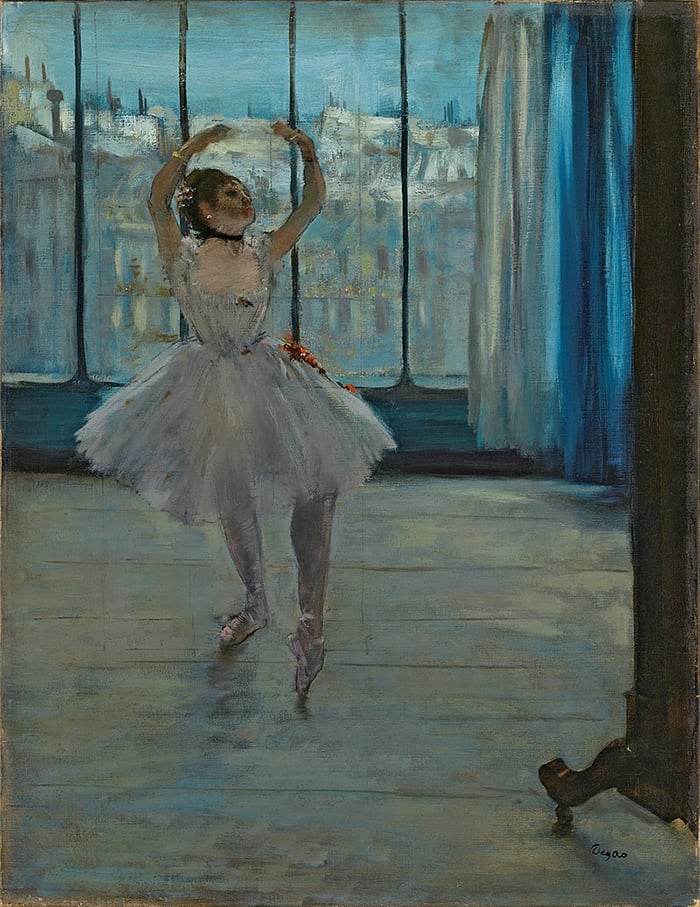
In Ballet Dancer, the dancer’s vibrant colors merge with the background. Her dress seems to be the key feature, with the most vibrant reds, oranges, and intricate patterns. Compare this to her understated face, hair, and arm. Degas himself said he was interested in “painting pretty clothes”.
Tip: As the artist, you decide what’s important.
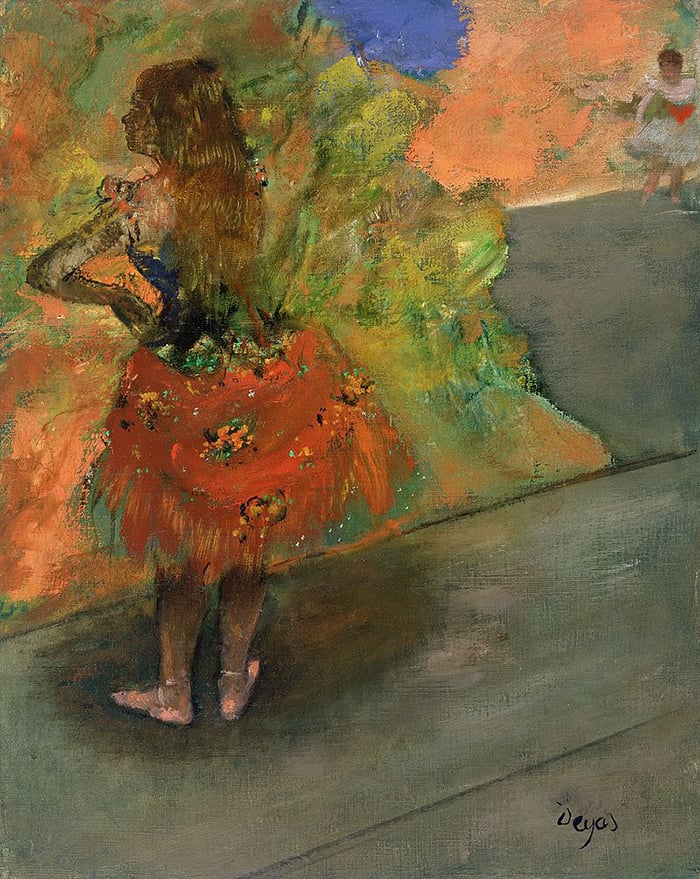
Ballet Rehearsal on Stage (below) is a grisaille painting, which is a fancy word to describe it’s lack of color. It was exhibited at the first Impressionist exhibition in 1874. Some critics considered it a drawing rather than a painting. Refer to artist Giuseppe De Nittis’ description of the painting in a letter to a friend:
“I remember a drawing that must have been of a dance rehearsal […] and I can tell you it was extremely beautiful: the muslin costumes were so diaphanous, and the movements so true to life that it has to be seen to be believed; it is just impossible to describe.”

Below is one of Degas’ later paintings, Dancers at the Barre, done in 1900. The two dancers are depicted with pale blues and grays against a vivid orange background. Usually, we see rich and vivid colors used for the main subject, not the background. Degas flipped the switch here.
The painting is held by The Phillips Collection and was restored in 2007. There’s some interesting commentary in this article published on their website.

Degas did a similar thing with Ballet Dancer With Arms Crossed. Vivid reds frame the delicate and understated dancer. Black outlines help distinguish the two areas.
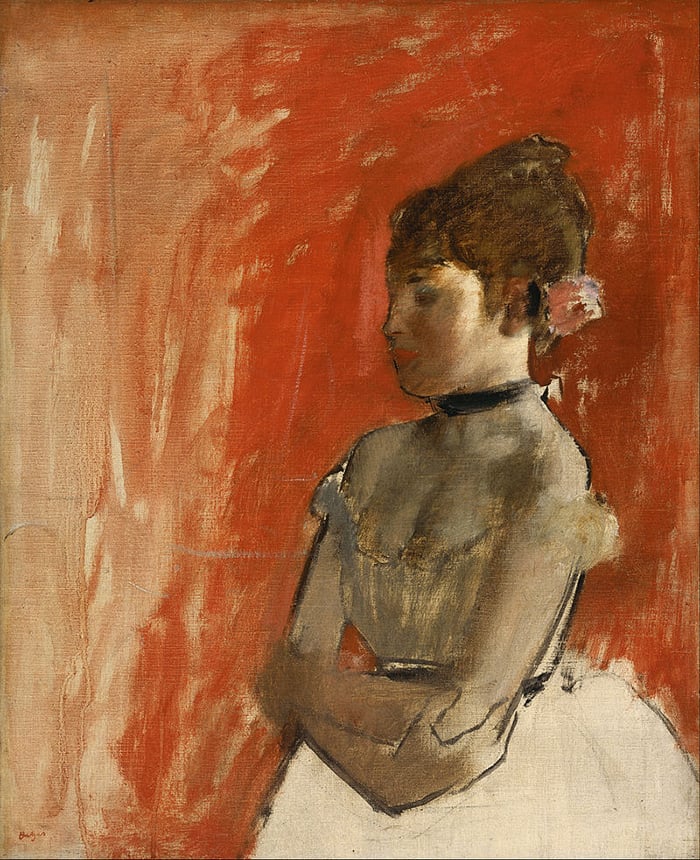
Dancer Studies and Sketches
Degas frequently visited the Paris Opera, though he rarely created studies there. He preferred working in his studio from memory or models.
“It is very good to copy what one sees; it is much better to draw what you can’t see anymore but is in your memory. It is a transformation in which imagination and memory work together. You only reproduce what struck you; that is to say, the necessary.” Edgar Degas via Understanding Art by Lois Fichner-Rathus






Compositions
Degas’ compositions are interesting, unconventional, and break many “rules”. Often candid snapshots of active scenes, as if his subjects weren’t aware they were being painted. This may have been the influence of photography.
Below is The Dance Lesson. It has unusual dimensions, being much wider than it is tall. This allowed Degas to cover a large area of the room without the ceiling and floor taking up much space in the painting.
The girl sitting hunched over in the bottom left corner is partially cropped out. Theory warns against this, but I find it works in this case. It adds to the candid nature of the scene and ensures this girl is not the key focus. Rather, she’s a part of the whole.
As with many of Degas’ paintings, instead of having a single dominant focal point, he opts for several lesser points of interest. This gives our eyes a number of different places to jump between.
The painting has a strong sense of depth and perspective. The girls get smaller in the distance, the colors weaker, and the detail softer. The vivid red on the nearest girl is an exclamation point.
Finally, a quick point on simplification. Notice how Degas didn’t detail the framed image hanging on the wall. You just get a faint suggestion of some colors and shapes. Though this is just a minor aspect of this painting, it’s an important lesson in general. Artists simplify the world; we don’t add more detail.

In the appropriately named Waiting (below), there’s a pleasant balance between positive and negative space. Positive being the dancer and who is perhaps her mother waiting on the bench. Negative being the surrounding floor and wall. Notice how the relatively small area of contrast, color, and detail is balanced against the larger “quiet” area.

The Dancing Class features a similar balance between positive and negative space. Had Degas used intricate detail for the background and floor, our attention would be diluted.
The black-suited violinist acts as a dark accent and a point of contrast for the delicate and white-dressed dancers. The mirror also adds an interesting dimension to the painting. It reminds me of Édouard Manet’s A Bar at the Folies-Bergère, which I wrote about in the Manet artist spotlight post.

Here’s Manet’s painting for reference. Is that a mirror on the right, or is it a double-sided bar? I remember there being some interesting discussion on this in the comments.

Below is Ballet Rehearsal (I can sense Degas was struggling to come up with different names for all these dancer paintings). The architecture, namely the grand windows in the back, provides a foundation of linear perspective. Notice how the lines in the room converge towards the same invisible point on the horizon line. This contrasts against the people in the room who are organic, dancing, living, moving. There is a subtle bridge between the rigid architecture and the dancers-look how the extended arms and legs of a few dancers reiterate the room’s perspective lines.

Key Takeaways
- Keeping the subject consistent allows you to better observe changes in other variables. Degas painted dancers over and over again in his study of movement.
- Movement is implied in some subjects. Think of something pointing, running, dancing. In “still” subjects, you need to rely on suggestive brushwork, line, contours, and color to create the illusion of movement and life.
- Line is a powerful visual element for outlining an object, creating a sense of movement, or reiterating shapes and forms.
- Use studies to gain a more intimate understanding of the subject before embarking on a larger studio piece.
- Composition rules and theory are merely there as a guideline, not a strict rulebook. Feel free to break the rules if it makes sense, as Degas did in many of his paintings.

Other Resources
- More Painting Breakdown Posts
- How to Capture Movement in Art
- Wikiart – A complete list of Degas’ artworks.
- Painting Academy – My fundamentals course.
- Master Artist Ebook Bundle – Get PDF ebooks of my best posts. Yours to download, print, and annotate.
Want to Learn More?
You might be interested in my Painting Academy course. I’ll walk you through the time-tested fundamentals of painting. It’s perfect for absolute beginner to intermediate painters.
Thanks for Reading!
I appreciate you taking the time to read this post and I hope you found it helpful. Feel free to share it with friends.
Happy painting!
Dan Scott

Draw Paint Academy

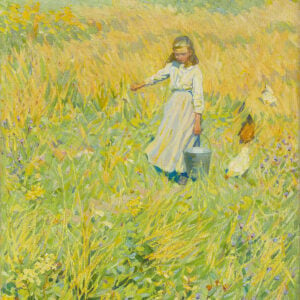
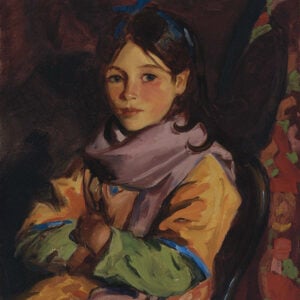
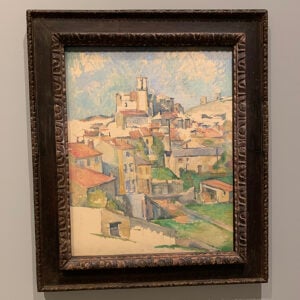
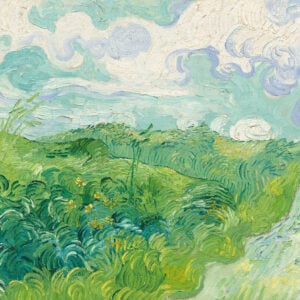
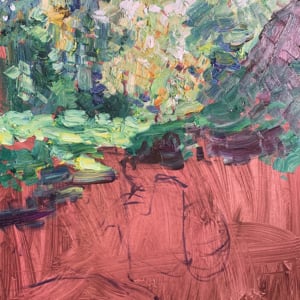
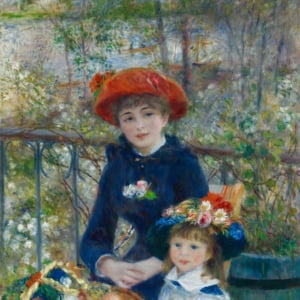
Thanks so much for that. So interesting. Lovely seeing a painting through another’s eyes. And thank you for all the wonderful gifts in your emails. Happy Christmas Dan.
Noting to say, Encyclopedia of painting ,a grand literature of painting ,you are serving. A lot of a Thanks ……….Vishnu Sharma
It’s interesting to note that many of the bright hi-lites in Degas’ paintings were obtained through the use of oil pastels…he was one the first to use these in his paintings.
I thought so! Since I use pastels it caught my eye.
Thank you so much Dan,very much appreciated.Wishing you a Merry Christmas and a Happy,Healthy New Year when it comes.
What a wonderful and insightful retrospective of Degas. You made me see his work in an entirely different way.
Bill
Remember going through all this 40 odd yrs ago at university
Thanks for this interesting piece on Edgar Degas. I appreciate all your analysis on the paintings. You are a great teacher, Dan. Have a merry Christmas and may 2021 be a happy one.
The lighting in Dancer with Bouquet of Flowers (from below) always makes me queasy. Degas knew how to make you stop and truly pay attention to a piece.
I really appreciate you taking the time to do this. I had not seen all of these paintings of Degas. Thank you.
I totally agree. One other thing I would have liked to know was what medium did Degas use.
Some I was able to confirm, but not on enough. (These were paintings I hadn’t see)
Thank you, Charlotte
Thanks for the great lesson!
Thank you for sharing this work. I especially appreciate your explanation of movement (with draw over) in Ballet at the Paris Opera.
Interesting information re the artists and paintings Appreciated
Fascinating.. love the insight
Hi Dan, This is my favorite of your postings! You are so accomplished, in your analysis of the great artist’s works..I am in awe of your knowledge.. I was just recently advised, by another advanced artist, that if I wanted to become a better painter, I should concentrate on painting one type of subject, and paint it many times, just as Degas, has done.. Since I have always loved snow scenes, that will be my study..
Thank you. I loved this study of Degas’ ballet dancers and your insight. Truly fascinating.
I had to keep going over and over these paintings to glean out the little details you don’t notice on a first cursory look. A great idea for a novice, practicing the same subject but with different line, lighting, colour etc. I learned so much.
Happy holidays !
Love the clear texture of these art pieces. Thanks for not forgetting me,
Bob Durocher
Insightful lessons and many of them. Thank you for sharing so much expertise that enlightens the creative mind.
Thank you for this piece on Degas and reminding me all I once learned about his work while in college. Degas has always been a favorite. His ballet prints hung in our home and in my local ballet studio when I was young. The suggestion of movement in his work always amazes me!
Wow, Dan. What a gift it has been to scroll through Degas’ paintings with your commentary. It helped me solidify some of the concepts I have been working on, and encouraged me to think in new directions too. Since I began painting, two years ago now, I have different eyes for seeing the world, and especially individual works of art. I was curious when looking at The Ballet at the Paris Opera 1877, to observe that Degas draws our eyes to that big peach colored ribbon on the dancer in the foreground, only to read later that he loved clothes and loved painting them. Then I read your notes that we choose what is important to us and are free to bring attention to whatever that may be. Thank you for sharing your knowledge and expertise.
I do appreciate you showing me movement. I always felt my work (botanicals mostly) was somewhat lifeless.
I agree that this is my favorite posting of yours! Yes, the remarkable analysis of movement, but also how much it says about you, Dan, and your art appreciation and mentoring abilities.
Thank you for this. Degas is one of the greatest artists of all time, period. So your e-mail was a welcome consideration of the ways in which he achieved the freshness and spontaneity which seemed so effortless in his paintings and sketches. It was a wonderful read, so thank you again–and have a wonderful Christmas and 2021!
Do you think Degas painted over some of his earlier paintings? I notice what looks like feet under the feet of the dancers on the left side of the stage, in Ballet Rehearsal on Stage, 1874.
Thank you so much for pointing that out! I went back to look and was amazed I didn’t notice it. My take on it: could it be that Degas changed his mind on the angle of where to put the dancers? The scrubbed out feet would have placed the foreground dancers in a more prominent position and would have lead the eye towards the stage on the right and stopping there, rather than into the centre of the painting and then following the dancers from the background to the middle ground and then stopping at the stage on the right.
Thank you once again for an interesting read, and taking the time to put it together, wishing you all the best for 2021.
Wonderful lesson! Thank you so much! You are very inspiring!
So interesting. I went back to read about Manet too. Thanks for these detailed essays.
Thanks for a very informative study of a great artist’s work. Like many other fields of art and, even may be science, when one is well established one is allowed to break the rules.
Happy holidays! I just joined and found this Degas review fantastic! I’ve seen lots of his work in different museums, but you made me realize I need to look closer… thank you, appreciate it
Though this posting is about Degas’ works, it is very interesting the fact about the double sided bar in Manet’s example. Great!!! Makes you think and wonder.
Why is their blue lines and arrows when both photos look like? Never seen photo of dancer sitting in a chair in the corner wearing point shoes; she is keeping her shoulders warm and from the elbows are on her lap; across from the spiral staircase; someone looks like a witch near her; they working on Cinderella? 2 evil sisters with evil god mother? Different fairytale story with a witch/evil dancer!! Hope everyone enjoys their pandemic Christmas and happy new year!!!
So interesting about The Bar at the folies-bergere. It’s always been explained to me before as a mirror but now I’m seeing it from a fresh perspective and trying to line up the objects to see if a mirror actually makes sense. It changes the whole scenario! Thank you. Still one of my favourite paintings because there is so much story there.
Dan points out features of Degas’s work that are, at first viewing, obscure, but with his guidance become obvious. We are learning to SEE.
Loved this. Love your posts
Thank you very much Dan for putting this all together as well as all the other exposees of this year. Degas is one of my favorite painters. His work is so uplifting in this crazy time and your analysis ads greatly to my understanding and appreciation of art. Wishing you a wonderful Christmas and lots of love and joy in the new year.
I found your comments about how Degas brought movement into still scenes through his brushwork and lines. Thank you
Your commentary is always appreciated. New eyes result in newer incites.
Thanks.
This was absolutely wonderful. I have not seen most of these paintings. Thank you So much.
These are the most breathtaking Degas paintings, that I had not
seen before. The Chicago Art Institute had an exhibit of Degas
paintings when I was around age 6 or 7, and was given an opportunity to sketch
from one of the paintings, which ultimately led to a career in art.
Thank you so much for sharing these awesome paintings as well as
your informative comments. I’m anxious to share this with some of my
artist friends.
artist friends.
Thank you for going thru and explaining some of the works of Degas. I really appreciat you doing this, it helps me look at each piece more thoroughly.
Marcia J.
Thank you for such a wonderful study on Degas, something beautiful in such worrying world wide troubling times. Christmas and new year greetings to you. I do appreciate receiving your interesting
studies, Thank you again.
I loved this class, you are a great teacher. I never saw all these details before and I had not seen most of these paintings.Thank you.
I have no idea what you’re talking about. Just like to look at degas paintings.
I like her comment. I spent many years studying. I don’t care I love the his work. It is simply amazing and beautiful. I saw the sculpture at the nd and I love his race horses and bathers but the ballerinas are my favorite. I was blessed to see the in by an mn
So enjoyed reading this. Thank you for taking the time
Enjoyed reading the article and saw Degas from his perspective.
Learning to appreciate more and more and learn more.
Thank You.
So enjoyed this and I am mentally trying to apply it to a picture of a drummer I started and put aside years ago because I did not have enough knowledge to proceed. My picture has a Mars orange underpainting, it has an element of the mystical, certainly has movement. I am wondering if Degas’ ways of emphasizing movement might be related to “sound”. Outdoors in a confined space, I recall hearing the deep sounds that went straight through me! Repeatedly through the years I have wondered how I might convey the sense of sound with paint.
Wonderful to learn some background on my favorite series of paintings by Degas
as i dancer i found it very interesting and realistic how he portrayed the dancers. happy holidays everyone! 😀
I am a novice painter discovering art in my retirement. After all the doom and gloom of 2020 it was wonderful to see this display of art. I have to admit I have tried my hand at one of Degas’s ballet paintings. I look at it now from my bed. So relaxing from my previous painting of Covid molecules 🙄
This was very enlightening–I’d never spent that much time understanding how these paintings work. You are agreat teacher. Thanks for sharing this was a great Christmas gift.
Amazing post! Such a variety of same subject: creativity indeed.
YOU made it possible for me to see and also UNDERSTAND each painting.
Thank you and Merry Christmas!
These are some of my favorite posts ever! Thank. You so much for sharing your insight into some of my favorite old masters. I especially enjoyed Sargents because I love watercolor.
You are amazing and so wonderful Dan, can’t thank you enough for your great contribution for the art. HAPPY CHRISTMAS
Enjoyed reading your insights on Degas works.
Thank you for sharing.
Thank you for your comments and knowledge of art. I will have to re-read several times to absorb the interesting info.
Opening your email and reading thru it today was a real treat and a Christmas present. Thank you, happy holidays, and a better New Year!
Loved this post!!! What Degas saud is so true. Difficult to show movement in paintings in one frame.
thanks for this post i loved verry much the drawings and the pastel colors
happy hollyday
A comment on Deux Danseuses. I appreciate learning how he uses scratchy brushstrokes & lines to convey movement. One thing i see that maybe you can comment on Dan. The girls are still for the most part as you say but the girl on the right is at a pose that i would think would be anatomically brief. She’s in a outstretched position kinda like when you touch your toes. Maybe subconsciencly, a viewer’s mind would be anticipating she’s in a rubber band position and soon will be moving to a relaxed position.
Just a crazy thought.
Thanks for all the drawings.
Dan; great, inspiring, and keeps artists focused on creating and being diverse in styles
I am intrigued with pressure: I try to look for its effect all around. In the dances I saw dynamic equilibrium. Different pressure points off set by different balancing points to achieve equilibrium. That is my two cents worth of any.
Loved it all! But just looked at latest on Fred Cuming.!! It made me weak in the knees!
Absolutely unbelievably beautiful, sensitive view of the lovely world around us.!! If I
Could paint just one like that, I’d die happy! Your a lovely teacher, by the way!! Thank you. P.s. his canvas of flowers in his garden is exquisite! Where does such sensitivity come from?
Great insight! I have some excellent take always!
Cheers
Thank you,it was so liberating ,inspiring and understanding Degas’ art
Not an artist but a former ballet dancer. Obviously, I’ve never seen the paintings from this perspective. It was quite fascinating. Thank you for your article. I truly enjoyed it.
I really love ballet,,
So in “Ballet at the Paris Opera, 1877”, all the audience is looking off to the right instead of at the stage and dancers. Why do you think that is? Is he just messing with us? Or is it part of a big curve through the audience around to the secondary dancers to finally end up on the main dancer? Wow, that’s control!
Thank you, very much!
Degas’ painting titled The Rehearsal at The Frick Madison in Manhattan, its temporary home, is not shown here. In addition to the dancers (including the raised leg of another otherwise outside the picture’s frame), the principal foreground figure is the violinist whose fingers and the bow on the violin are clearly playing a specific note at that moment in time. A strange curiosity on my part wishes a violinist reading this can respond by providing the note he is playing at that point in the composition. Thank you.
I don’t understand , you give flowing commentary on all of Degas work but not a peep on Manet’s Bar painting. Its about Degas, i get it. But then why in the Hell insert a Manet painting with no commentary. At best its misleading and at worst its a confusing article to throw in an irrelevant piece of art with no elaboration or context.
Thank you very much Dan for putting this all together as well as all the other exposees of this year. Degas is one of my favorite painters. His work is so uplifting in this crazy time and your analysis ads greatly to my understanding and appreciation of art. Wishing you a wonderful Christmas and lots of love and joy in the new year.
Not an artist but a former ballet dancer. Obviously, I’ve never seen the paintings from this perspective. It was quite fascinating. Thank you for your article. I truly enjoyed it.
Brilliant and inspiring!
Günlük hayatın koşuşturmacası içinde bazen yalnızlık hissedebiliriz. İşte tam da bu noktada sohbet platformları devreye giriyor. Bu platformlar sayesinde dünyanın her yerinden insanlarla tanışabilir, sohbet edebilir ve yeni dostluklar kurabilirsiniz.
Evli ve yalnız hissediyorsanız, evli sohbet platformları tam size göre. Bu platformlarda benzer duygular yaşayan diğer evli insanlarla tanışabilir, sohbet edebilir ve deneyimlerinizi paylaşabilirsiniz.
Bazı sohbet platformları ücretli üyelik sistemiyle çalışırken, birçok platform da ücretsiz sohbet imkanı sunuyor. Parasız sohbet platformları sayesinde bütçenizi zorlamadan yeni insanlarla tanışabilirsiniz.
Yabancı dil bilmiyorsanız veya Türkçe sohbet etmeyi tercih ediyorsanız, TR sohbet platformları ideal bir seçim olacaktır. Bu platformlarda Türkiye’den ve dünyanın farklı yerlerinden Türk kullanıcılarla sohbet edebilirsiniz.
Konuşmayı seviyorsanız ve sohbet etmeyi bir hobi olarak görüyorsanız, https://mekansohbet.com.tr geveze sohbet platformları tam size göre. Bu platformlarda saatlerce sohbet edebilir ve yeni bilgiler edinebilirsiniz.
Sohbet etmenin keyfini çıkarmak ve yeni insanlarla tanışmak için sohbet-yap-esohbet platformları ideal bir seçim olacaktır. Bu platformlarda farklı kategorilerde sohbet odaları bulabilir ve ilginizi çeken sohbetlere katılabilirsiniz.
Yukarıda bahsedilen tüm sohbet türleri için birçok farklı platform mevcut. En iyi platformu seçerken aşağıdaki faktörleri göz önünde bulundurabilirsiniz:
Ücretli veya ücretsiz: Platformun ücretsiz veya ücretli üyelik sistemiyle çalışıp çalışmadığını kontrol edin.
Güvenlik: Platformun güvenli bir ortam sunup sunmadığından emin olun.
Kullanıcı sayısı: Platformda aktif olan kullanıcı sayısının fazla olması daha fazla insanla tanışma şansı sunacaktır.
Özellikler: Platformun sunduğu özel features’ları inceleyin.
Sonuç:
Sohbet platformları, yalnızlık hissini yenmek ve yeni insanlarla tanışmak için ideal bir ortam sunuyor. Yukarıda bahsedilen bilgiler ışığında kendinize en uygun platformu seçerek sohbet etmenin keyfini çıkarabilirsiniz.
thank you very much admin.